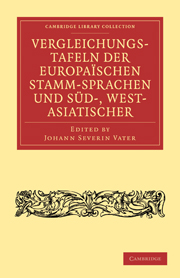Book contents
- Frontmatter
- Vorrede
- Anmerkungen en vorstehenden Vergleichungetafeln
- Vergleichungstafeln der Declination und Conjugation der Europäischen Stammsprachen und West-, Süd-Asiatischer
- R. K. Rask über die thrakische Sprachelasse
- Grammatik der Albanesischen Sprache nach Fr. Mar. da Lecee
- Grusinsche oder Georgische Sprachlehre nach Maggio, Ghai und Firalow
- Galische Sprachlehre
- Anhang
Grammatik der Albanesischen Sprache nach Fr. Mar. da Lecee
Published online by Cambridge University Press: 04 April 2011
- Frontmatter
- Vorrede
- Anmerkungen en vorstehenden Vergleichungetafeln
- Vergleichungstafeln der Declination und Conjugation der Europäischen Stammsprachen und West-, Süd-Asiatischer
- R. K. Rask über die thrakische Sprachelasse
- Grammatik der Albanesischen Sprache nach Fr. Mar. da Lecee
- Grusinsche oder Georgische Sprachlehre nach Maggio, Ghai und Firalow
- Galische Sprachlehre
- Anhang
Summary
Bei Untersuchungen über die alte thrakische und illyrische Sprache kann der Blick nicht die Albanesen vorbeigehen, welche jetzt jene Gegenden bewohnen. Die Vermuthungen über ihre Abstammungen zu prüfen, ist hier nicht der Ort, nicht zu Nachweisungen der Stellen alter Schriftsteller, wo illyrische Wörter erwähnt werden; (ich habe sie, so viel möglich, im Mithridates, Bd. II. zu J. Chr. Adelungs Ansichten von thrakisch-illyrischen Völkern nachgetragen.)
Der Bau der albanesischen Sprache soll (ausführlicher, als ich ihn im Mithridates bezeichnen konnte) mit den Paradigmen selbst, den Sprachforschern vorgelegt werden. Franz Maria da Lecceosservazioni grammaticali nella lingua Albanese (Rom 1710. 4to) sind die einzige Quelle dazu; doch haben sich begreiflich in dem Folgenden bequemere Anordnungen, zur Erleichterung der Uebersicht, welche auch zur Vergleichung der lateinischen Conjugationen mit einigen albanesischen dient, treffen lassen.
Ueber die Gegend der verbreiteten albanesischen Nation, für welche jene Osservazioni zunächst galten, ist dort Nichts gesagt; aber in der neuesten Zeit hat F. C. H. L. Pouqueville in seinem geschätzten voyage dans la Grèce, sich weitläufig über diese Nation, ihre sich durch Dialekte unterscheidenden Stämme und deren Wohnsitze verbreitet, und den eigentlichen Namen des Volks aufgestellt, den diese sogenannten Albanesen oder Arnauten allein anerkennen: Schypetar; die Sprache nennt er laugue schype.
- Type
- Chapter
- Information
- Publisher: Cambridge University PressPrint publication year: 2010First published in: 1822

